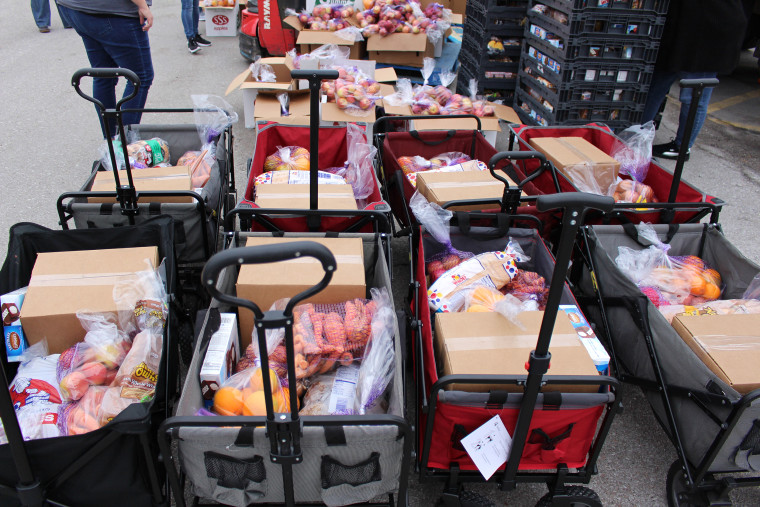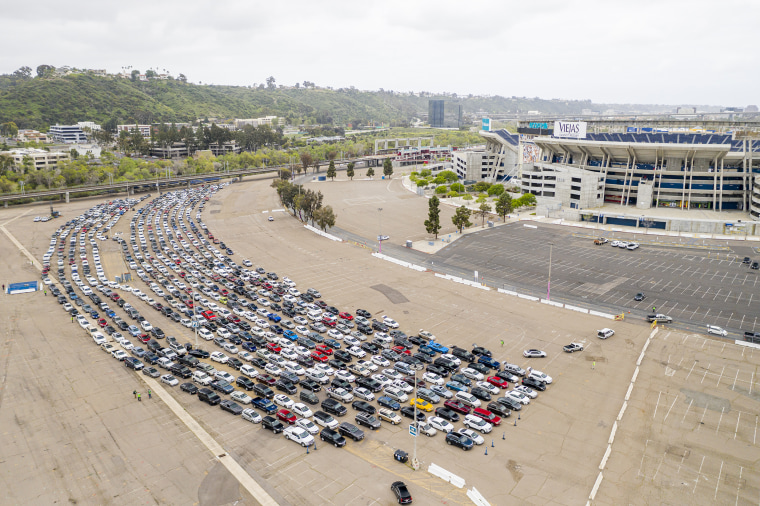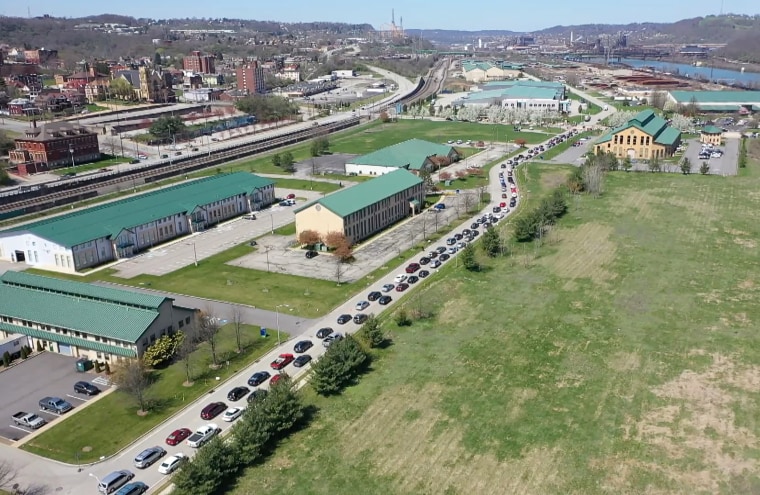In an average month, Brian Barks, the CEO of Food Bank for the Heartland, spends about $73,000 buying food to distribute to people in need across Nebraska and western Iowa.
Last month, as the coronavirus was spreading across the U.S., he spent $675,000.
That's a nearly tenfold increase, because Food Bank for the Heartland, like food banks and pantries across the country, is facing a steep drop-off in the bread and butter of its operations: food donated by supermarkets and farms.
"The grocery stores, as we've seen across the country, the shelves are getting bare," Barks said. "They don't have extra to hand out to food banks. And what we're anticipating is that those donations will drop to zero."

When the national nonprofit Feeding America surveyed its affiliated food banks in mid-March, 92 percent said they were seeing increased need, while 64 percent said food donations had declined.
As a result, Barks and other food bank directors are facing a dual challenge in the era of COVID-19: drastically overhaul the way they do business — with fewer volunteers and less person-to-person contact — while trying to feed a surge of Americans newly facing food insecurity because of the virus.
Full coverage of the coronavirus outbreak
At times, the two goals can seem diametrically opposed.
"One of the huge concerns that we have here," Barks said, "is that many of the pantries that receive food from food banks are operated by seniors. And when those seniors say, 'You know what? I'm not going to risk it anymore,' those pantries close. Then what do you do? That is where approximately 70 percent of our food goes, through a network of pantries."
To provide food in the age of social distancing, many food banks and pantries have pivoted to low-contact, drive-thru food distribution.

At Feeding San Diego's emergency drive-thru distribution Saturday, vehicles lined up 14 deep in the SDCCU Stadium parking lot for boxes filled with produce and nonperishable food. About 1,200 vehicles were served until the food bank ran out in just under an hour.
"We're seeing as much as a 40 percent to 50 percent increase in demand at individual distribution locations," CEO Vince Hall said. "Many of the people that we're seeing have never before sought food assistance. Many of them aren't even sure what the process is. We get lots of very fundamental questions: 'Do I qualify? Is there somebody more deserving than me?'"
Hall said he, too, is being forced to rely on purchased food more than ever. "We usually rescue about 12 million pounds of food per year from grocery stores across our county," he said. "Well, consumer demand has depleted those grocery stores. And now there is almost nothing left for us to rescue off the loading dock."
In the last 2½ weeks, Feeding San Diego has bought 36 truckloads of food. That's more than the food bank normally purchases in a year.
"Whatever constellation of economic factors comes to bear on them, they went from having a middle-class life to being in need of hunger relief services in a snap of a finger," Hall said. "And so that is all creating complex challenges for the food distribution system."
Around the country, food banks and pantries have taken on the challenge in different ways.
In New York City, the nonprofit food rescue organization City Harvest said 82 of the food programs it delivers to have shut down because of precautions or lack of staffing. Drive-thru distribution isn't an option for most New Yorkers, making it even harder than usual to find food assistance in a city where 2.5 million people struggled to make ends meet even before COVID-19 arrived.
To help offset the closings of other programs, City Harvest is continuing to run its "mobile markets" across the city, allowing New Yorkers in need to pick up produce on foot. The nonprofit said it's seeing a 30 percent uptick in attendance at those markets.
In Albuquerque, New Mexico, a Meals on Wheels program that delivers to shut-ins has switched from delivering hot meals Monday through Friday to delivering frozen meals once a week.
And at the Harrison Food Bank in Harrison, Maine, where a large elderly population raises the stakes, volunteers and staff members drive more than 200 miles a day, six days a week, picking up food from pantries that have shuttered and crisscrossing the state to amass enough food to feed their community.
Like dozens of other food banks and pantries nationally, Hall's food bank in San Diego and Barks' food bank in Omaha are relying on skeleton crews of staff members and experienced volunteers for safety while trying to meet the unprecedented need.
"I've never been involved in anything so fluid in my life," said Barks, whose staff in Nebraska has a backlog of food assistance applications to process under the federal Supplemental Nutrition Assistance Program. "The goalposts seem to change, not just by the day but by the hour. And when you're in the business of trying to feed people who need food, it's really, really challenging."
Download the NBC News app for full coverage and alerts about the coronavirus outbreak
At the Greater Pittsburgh Community Food Bank, volunteer staff members have also been pulled back, but the National Guard stepped in to provide emergency assistance.
"Now, as opposed to packing 2,000 boxes a day, with their help we're packing 3,000 emergency food boxes a day," CEO Lisa Scales said.
On Monday afternoon, at one of its drive-thru distribution operations, over 15,785 pounds of food were handed out every hour. The line of vehicles wrapped down a nearby highway and stretched over 2 miles long.

"We've been in operation for almost 40 years, and this is the most significant increase in need in a short of period that I've experienced. And I've been in food banking for 25 years. The vast majority of people we're serving these past several weeks are people who are newly unemployed," Scales said.
Like the organizations in Nebraska and San Diego, the food bank in Pittsburgh is expending vast resources to fill the gap left by donated and rescued food. Scales has spent $1.7 million on nonperishable food for March and April, up from $600,000 during the same months last year. But she's also having difficulty sourcing that food, as food banks, supermarkets and other businesses all vie for the same products.
"Just this week, we had four of our food orders canceled," Scales said. "And we heard that another four of our food orders are being shorted, which means that we're receiving less than what we were told we would get...The food is being bought out from under us by other retail businesses that are willing to pay a higher price."
Still, Scales is dogged in her insistence that the food bank will find a way. To her, the alternative isn't acceptable.
"It's what keeps me up at night," she said.
